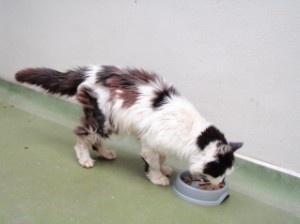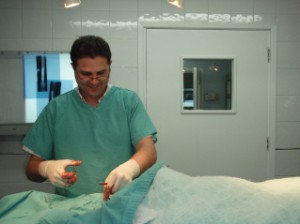Hyperthyroidism in Cats
Hyperthyroidism ( an over-active Thyroid gland) is one of the most common diseases seen in older cats. It is easily diagnosed by blood tests and can be treated with either tablets, surgery or radiotherapy. Treated cats can go on to live normal lives. It is very rare in dogs.
What is Hyperthyroidism?
- Hyperthyroidism is one of the most common hormonal diseases seen in older cats.
- It generally occurs in cats over 12 years old.
- A cat who is Hyperthyroid has an overactive thyroid gland.
- There are 2 thyroid glands in the body, one either side of the trachea ( windpipe) in the neck.
- They produce the hormone Thyroid, which controls the speed of the bodies metabolism.
- It is more common in people to be Hypothyroid. A person who is Hypothyroid becomes tired, sluggish and gains weight very easily, the symptoms of a hyperthyroid cat are the opposite of this.
- Cats who are Hyperthyroid have too much of the hormone thyroid in their system, which makes their metabolism go far too fast.
- Hyperthyroidism is very rare in dogs, they more commonly suffer from Hypothyroidism ( an under-active thyroid gland). To learn more about this, click here.
What causes Hyperthyroidism?
- Usually both of they thyroid glands in the neck become over-active, but generally one is larger than the other, and more easily felt by the vet.
- It is not known what causes this enlargement and the over-production of Thyroid hormone.
- In the majority of cases this enlargement is benign. This means it is not cancerous and will not spread.
- In a minority of cases (1-2%), the enlarged glands are cancerous, and in these cases it needs to be removed.
What are the symptoms of Hyperthyroidism?
- The symptoms of hyperthyroidism are all related to the increased speed of the affected cats metabolism, which is caused by the raised levels of thyroid hormone.
- These symptoms can come on slowly over weeks or months, as the thyroid hormone levels gradually rise, so it can be difficult at first to realise there is a problem
Symptoms of hyperthyroidism include;
- Increased appetite - affected cats will often eat large amounts, and it can be difficult to satisfy their hunger.
- Increased water intake
- Weight loss - despite an increased appetite, cats with hyperthyroidism usually lose weight, and this is often the first indicator of the disease.
- Increased heart rate - the high metabolic rate will cause the heart to beat much faster than normal. A normal cats heart will beat about 180 times per minute, a cat with hyperthyroidism will often have a heart rate of over 250.
- Vomiting and diarrhoea - the intestinal system is forced to move very fast due the the cats increased metabolic rate. Cats will often vomit, generally soon after having eaten, and diarrhoea is also common, as food moves through the guts too quickly to be digested properly.
- Palpable thyroid gland - vets and sometimes owners too, can often feel the enlarged thyroid gland in the cats neck. It is a small, mobile and non-painful lump, just the the side of the trachea ( windpipe)
- Poor coat condition - cats will often have dull and unkempt coats. This is due both to their general ill health, and the fact that they will often stop grooming themselves properly.
- Anxious expression - vets will often describe cats as ‘looking Hyperthyroid’, this is due to the wide eyed and anxious expression affected animals often have.
Hyperthyroidism is an important disease to diagnose and treat, as the increased metabolic rate will have many detrimental effects on the body including;
- Heart failure - because the heart is beating so fast, the muscle of the heart will thicken and become less flexible. This will eventually result in heart failure.
- Liver damage - the liver is the ‘metabolic powerhouse’ of the body and involved in a huge amount of bodily functions. The increased metabolism forces it to work at an increased rate, and if left untreated can cause permanent damage.
- Emaciation - left unchecked a Hyperthyroid cat will lose weight to the point where they become emaciated. This is obviously a huge strain on the body and extremely damaging to all body systems.

This cat is a typical example of Hyperthyroidism. It is very thin, has an unkempt coat, and a ravenous appetite.
How is Hyperthyroidism diagnosed?
- Hyperthyroidism is easily diagnosed by a simple blood test which measures the levels of the hormone Thyroid in the blood.
- Normal cats will have levels of less than 60mmol/l but cats with hyperthyroidism will generally have levels over 100mmol/l and some can have levels over 200mmol/l
- The level of thyroid in the blood when the cat is diagnosed is not related to how successful the treatment will be. Cats with very high levels can be controlled just as easily as those with much lower levels.
- Blood tests may also show signs of liver strain, but this is usually reversible once the Hyperthyroidism has been treated.
- An important point to note about hyperthyroidism is that high thyroid levels can mask the signs of kidney failure on blood tests. It is therefore important to repeat blood tests once the thyroid levels are under control to screen cats for kidney failure. Kidney failure is also very common in older cats, and having one problem doesn’t mean they can’t have two!
How is Hyperthyroidism treated?
- There are 3 different ways in which cats with Hyperthyroidism can be controlled; tablets, surgery or radiotherapy.
- Once Hyperthyroidism has been diagnosed, it is a permanent disease, unless the over active gland is removed or destroyed.
Tablets
- Regular tableting is the most common way of treating Hyperthyroidism.
- The most commonly prescribed tablets are given twice daily, but there has very recently been a new kind of tablet introduced which require only once daily dosing.
- The tablets can be given with food, or put straight into the cats mouth. If possible try not to crush them up and hide them in the food as they can be bitter tasting once crushed, and also the sugar coating prevents then from being destroyed by the stomach acid.
- The tablets work by neutralising the excess thyroid hormone once it has been released by the thyroid gland, they have no effect on the over-active gland itself.
- The tablets are a life-long treatment, if they are not given, the levels of thyroid hormone will rise and the original symptoms will return.
- They are very safe, side effects can occur, but they are rare, and will generally resolve if the treatment is stopped or changed.
- Regular blood tests, every 3-6 months, should be taken to monitor the thyroid levels and kidneys.
Regular tablets, either once or twice daily, are the most common way to treat Hyperthyroidism.
Surgery
- Surgery can be performed to remove the over-active thyroid gland, it is a relatively simple procedure and it is curative.
- It is particularly useful for cats who are difficult to tablet, or where twice daily tableting is not possible.
- The cat will need to undergo a general anaesthetic, these do carry a higher risk in older patient, but your vet will be able to talk you through the procedure and ensure every care is taken to make it as safe as possible.
- It is important that the thyroid levels are normal before the operation is carried out, so cats will need to be given tablets for at least 3-4 weeks before the surgery.
- Blood tests are usually taken before the operation to ensure the thyroid levels are normal, and also to ensure there are no other complications, such as kidney disease.
- There are usually very few complications following surgery, the most common is related to the parathyroid gland.
- The parathyroid gland is a small hormone gland thats sits on top of the thyroid gland, and is involved controlling calcium levels in the body. If it is damaged or removed during the operation then then it is possible for the calcium levels in the body to fall very low. However, it is an unusual complication as there are 2 parathyroid glands, one associated with each thyroid gland. If one gland is damaged, the other will usually take over.

Surgery is a curative option for Hyperthyroidism. Sometimes two operations are necessary so each gland is removed seperately, to reduce the chances of side effects.
Radiotherapy
- This is a curative procedure during which the cat is injected with radioactive iodine, I131.
- The iodine is not harmful to the cat, it collects in the thyroid glands and destroys them from the inside out.
- It is a referral procedure and can only be carried out at a few specialist centres around the country.
- The advantages of this procedure are;
- It has no serious side effects
- The cat does not require an anaesthetic to be injected ( although some particularly fractious animals may require a mild sedation)
- It is a curative procedure in 95% of cases, all the thyroid tissue is destroyed.
- It has no effect on the parathyroid glands, so there are no complications with the cats calcium metabolism.
- The disadvantages of this procedure are;
- The cat is injected with a radioactive medication, which is harmless to the cat, but can be only minimally handled by the veternarians.
- The cat will produce radioactive waste for 3-6 weeks after they have been injected, and so they need to be hospitalised in a specialised facility for that time.
- It is expensive, costing between £1000-1500, although it would be covered by pet insurance.
Monitoring Hyperthyroidism
- Once the correct dosage of tables has been established, Hyperthyroid cats tend to remain very stable.
- However, it is important to monitor the thyroid levels in the blood at least every 6 months, and also to monitor their kidney function as kidney failure is also very common in older cats.
Hyperthyroidism in cats is a very common disease, but it is easily diagnosed with blood tests and easily treated with either regular medication, surgery or radiotherapy. Once the disease has been cured, or is under control, cats can go on to lead normal lives.
Please note, this is an advice only website. If you have any specific queries about your pet, you should contact your vet